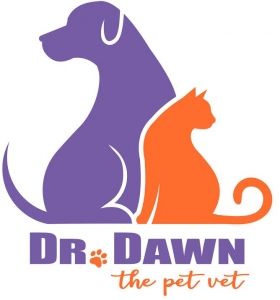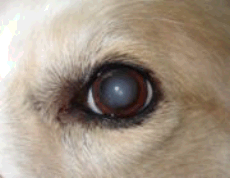Older dogs will, at some point, have changes in their eyes that show their age. By a certain age, I expect them, and clients typically say that their dog has cataracts. This is a very common misconception, as people often get cataracts, and we just expect that what we are seeing in our older dogs is the same thing. Yet, often they have another older eye change, and it’s important to distinguish the two conditions, and have your veterinarian decide which of the two is present in your pet.
Quick anatomy lesson:
The normal lens of the eye is used for focusing and is completely clear. It is help in place by fibers. Interestingly, the focusing power of the dog’s lens is at least 3 times weaker than that of a human, and a cat’s lens is approximately half the power of a human’s. Thus, dogs and cats rely on their amazing sense of smell much more to perceive the world.
When an animal ages, the lens loses its ability to change its size and grow larger, and becomes more dense and cloudy. This condition is caller nuclear sclerosis, and although the eye appears cloudy to you and I, the dog can still see through the lens. These are not cataracts. The lens is enclosed in a capsule that, if disrupted, allows the immune system to react to it, which causes it to attack the lens and cause problems. This inflammatory process can cause cataracts, in addition to other causes
Example of Nuclear Sclerosis. Not a cataract
Cataracts:
A cataract is an opacity in the lens that cannot be seen through. As the size of the cataract grows, the field of vision is diminished. It can thus, if big enough, and in both eyes, cause blindness. But that’s not the only problem that it can cause. It can also luxate, which means that it slips from the strands that hold it in place. This can cause it to move in the eye, inflame the eye and cause pain, and potentially lead to glaucoma, which is painful and can lead to blindness. Certain breeds are more prone to cataracts. The list of breeds is quite long, although a recent study determined that miniature and toy poodles, and cocker spaniels are among the more common breeds afflicted. Toxins, injuries to the eye, and diabetes are also other causes of cataracts.
Example of a cataract. Note the Y shape, occasionally seen with this condition
The distinction between the two eye conditions is important, because one can be treated, and the other does not need to be. Cataracts also can begin to dissolve after they have been there long enough. This is not good, as it can be a highly inflammatory process, potentially leading to glaucoma. Small cataracts don’t typically cause problems, but the bigger ones can be graded and monitored.
Treatment:
The definitive way to treat a cataract is with surgery, which either removes or dissolves the cataract. This is in the case of a cataract that has progressed to the point where it is causing blindness, inflammation or glaucoma, or a combination thereof. The surgery option can be expensive and is not always an option. Your veterinarian can help to determine which condition your dog has, and more importantly, determine if there are secondary complications that might be addressed medically. In certain situations, medical intervention can address those complications. This can be a less costly alternative to surgery, and make your dog more comfortable, and may slow down the disease process caused by the cataracts.
Dr. Dawn
Please share and subscribe here








Dr. Dawn, A very timely article for us since Smokey has eye issues and turns out, nuclear sclerosis. Good to understand the anatomy and difference between nuclear sclorisis and cataracts. Ever informative!
Thanks,
Donna
Glad you found it useful info. Pretty much something we will all deal with eventually, as our puppies get older.